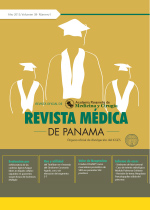USO Y UTILIDAD DEL TIROFIBAN EN EL MANEJO DEL SÍNDROME CORONARIO AGUDO, CON Y SIN ELEVACIÓN DEL SEGMENTO S-T
Autores/as
DOI:
https://doi.org/10.37980/im.journal.rmdp.2013112Resumen
Resumen Presentamos diez pacientes con síndrome coronario agudo. Ocho no tenían elevación del segmento S-T. Todos fueron tratados con alta dosis en bolo de Tirofiban (25 mcg/kgs), más una dosis de mantenimiento (0.15 mcg/kg/min.) durante 24 horas. Los pacientes sin elevación del segmento S-T, fueron cateterizados y, de acuerdo a los hallazgos en dicho estudio, se les realizó una terapia coronaria percutánea. En los pacientes con elevación del segmento S-T el Tirofiban se inició al momento de realizado el cateterismo diagnóstico. En tres pacientes (dos con elevación y uno sin elevación del S-T) la infusión de Tirofiban fue prolongada por 48 horas por la “carga trombótica” visualizada en la arteria al momento de la angiografía. En estos tres pacientes se pudo constatar, por angiografía, la disminución significativa de la trombosis arterial al cabo de este tiempo. Dos pacientes recibieron un tratamiento coronario percutáneo por catéter y un paciente fue operado, al definirse que la obstrucción involucraba el ostium de la arteria descendente anterior. Todos los pacientes evolucionaron sin complicaciones, sin requerir nuevas revascularizaciones o presentar infartos o morir. No hubo complicaciones hemorrágicas. Debemos mencionar que todos los pacientes, además del Tirofiban, recibieron ácido acetil salicílico, clopidogrel y heparina de bajo peso molecular.
Colaboración de la Academia Panameña de Medicina y Cirugía e Infomedic International S,A. 2006-2013. Derechos reservados. www.revistasmedicas.org
Use and usefulness of tirofiban in the management of acute coronary syndrome with and without ST segment elevation
Summary
Ten patients presenting with acute coronary syndrome. Eight did not have elevation of S-T segment. All were treated with high-dose bolus tirofiban (25 mcg / kg), plus a maintenance dose (0.15 mcg / kg / min.) For 24 hours. Patients without ST segment elevation were catheterized and, according to the findings in this study underwent percutaneous coronary therapy. In patients with ST segment elevation tirofiban started when the diagnosis catheterization. In three patients (two with lift and one non-ST) infusion of tirofiban it was extended by 48 hours for the "thrombus burden" displayed in the artery at the time of angiography. In these three patients it was found by angiography, significant decrease of arterial thrombosis after this time. Two patients received percutaneous coronary catheter treatment and one patient was operated by defining the obstruction involving the ostium of the left anterior descending artery. All patients recovered without complications, without requiring new revascularization or have heart attacks or die. There were no bleeding complications. We should mention that all patients, plus tirofiban received acetylsalicylic acid, clopidogrel and low molecular weight heparin.
Palabras claves: Supradesnivel S-T, infradesnivel S-T, trombosis arterial, tirofiban, abciximab, glicoproteínas IIb-IIIa.
Key Word: ST elevation, ST depression, arterial thrombosis, tirofiban, abciximab, glycoprotein IIb-IIIa.
Descargas
Publicado
Número
Sección
Licencia
Derechos autoriales y de reproducibilidad. La Revista Médica de Panama es un ente académico, sin fines de lucro, que forma parte de la Academia Panameña de Medicina y Cirugía. Sus publicaciones son de tipo acceso gratuito de su contenido para uso individual y académico, sin restricción. Los derechos autoriales de cada artículo son retenidos por sus autores. Al Publicar en la Revista, el autor otorga Licencia permanente, exclusiva, e irrevocable a la Sociedad para la edición del manuscrito, y otorga a la empresa editorial, Infomedic International Licencia de uso de distribución, indexación y comercial exclusiva, permanente e irrevocable de su contenido y para la generación de productos y servicios derivados del mismo. En caso que el autor obtenga la licencia CC BY, el artículo y sus derivados son de libre acceso y distribución.






